
|
Now it is bright as 8.9 mag (June 4, Chris Wyatt). It stays bright as 9 mag for a while. In the Southern Hemisphere, it stays observable in good condition for a long time until the comet will fade out. In the Northern Hemisphere, it is observable only until June.
Date(TT) R.A. (2000) Decl. Delta r Elong. m1 Best Time(A, h)
June 9 18 58.62 -30 10.0 1.368 2.324 154 9.3 1:52 ( 0, 25)
June 16 18 38.58 -35 34.6 1.313 2.300 161 9.2 1:05 ( 0, 20)
|
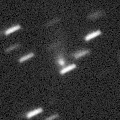
|
Now it is not observable. It will brighten up to 9 mag in summer, but it is hardly observable when it is bright. In the Northern Hemisphere, it is not observable until late December. In the Southern Hemisphere, it is observable from July to September, but it locates in extremely low.
Date(TT) R.A. (2000) Decl. Delta r Elong. m1 Best Time(A, h)
June 9 4 8.65 17 33.6 2.059 1.108 14 11.0 3:00 (238,-13)
June 16 4 28.65 14 18.7 1.942 1.029 18 10.6 2:58 (241,-14)
|
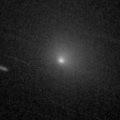
|
It brightened rapidly as expected. Now it is very bright as 10.7 mag (May 25, Chris Wyatt). It stays at 10-11 mag until June. In the Southern Hemisphere, it stays observable in excellent condition. In the Northern Hemisphere, it will be unobservable from April to June when the comet becomes brightest.
Date(TT) R.A. (2000) Decl. Delta r Elong. m1 Best Time(A, h)
June 9 0 18.08 -28 18.3 0.909 1.320 86 10.9 3:00 (309, 4)
June 16 0 35.53 -26 13.2 0.915 1.343 87 11.5 2:58 (308, 6)
|
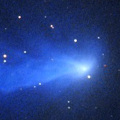
|
Now it is 11.3 mag (May 15, Juan Jose Gonzalez). It stays bright as 11 mag for a long time until autumn. In the Southern Hemisphere, it is not observable for a long time after this. In the Northern Hemispehre, it stays observable for a long time until the comet fades out. But it stays very low until autumn.
Date(TT) R.A. (2000) Decl. Delta r Elong. m1 Best Time(A, h)
June 9 6 42.37 49 40.6 3.419 2.622 32 11.2 20:58 (142, 14)
June 16 7 1.14 50 29.9 3.441 2.633 31 11.2 21:02 (144, 13)
|
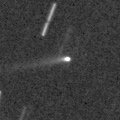
|
First return of a new periodic comet which brightened up to 13 mag in 2013. Now it is 14.2 mag (June 3, Michael Mattiazzo). It will brighten very rapidly after this, up to 11 mag in summer. In the Southern Hemisphere, it stays observable in good condition all through this apparition. In the Northern Hemisphere, it is not observable at the high light from mid June to mid August.
Date(TT) R.A. (2000) Decl. Delta r Elong. m1 Best Time(A, h)
June 9 8 57.28 15 17.7 0.464 0.836 54 12.7 20:58 ( 96, 18)
June 16 8 54.00 10 7.9 0.404 0.809 48 12.0 21:02 ( 96, 8)
|
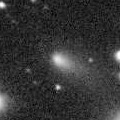
|
Now it is 14.4 mag (May 21, Toshihiko Ikemura, Hirohisa Sato). It will brighten rapidly, and brighten up to 7 mag from August to September. In the Northern Hemisphere, it will be observable in excellent condition. In the Southern Hemisphere, it will be unobservable from July to August. But it will be observable in good condition before and after tha.
Date(TT) R.A. (2000) Decl. Delta r Elong. m1 Best Time(A, h)
June 9 20 42.75 37 36.4 1.067 1.608 101 12.7 3:00 (247, 83)
June 16 20 55.46 41 31.9 0.993 1.544 100 12.2 2:58 (211, 82)
|

|
Now it is 11.6 mag (May 15, Juan Jose Gonzalez). It stays 12 mag for a long time until spring in 2019. In the Northern Hemisphere, it stays observable in good condition for a long time, although it becomes unobservable temporarily from mid June to August. In the Southern Hemisphere, it is not observable until September.
Date(TT) R.A. (2000) Decl. Delta r Elong. m1 Best Time(A, h)
June 9 8 1.43 43 20.1 3.381 2.701 41 12.2 20:58 (128, 22)
June 16 8 5.73 41 0.8 3.447 2.691 35 12.2 21:02 (129, 16)
|
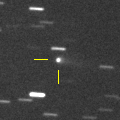
|
Now it is 14.7 mag (May 21, Catalina Sky Survey). It will brighten rapidly after this, and it will brighten up to 11 mag from summer to autumn. It is observable in excellent condition in the Southern Hemisphere. It locates somewhat low in the Northern Hemisphere.
Date(TT) R.A. (2000) Decl. Delta r Elong. m1 Best Time(A, h)
June 9 22 4.57 -15 5.3 1.487 2.068 109 12.6 3:00 (326, 33)
June 16 22 13.32 -15 20.1 1.411 2.055 114 12.4 2:58 (331, 35)
|
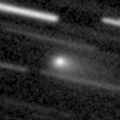
|
Now it is bright as 12.7 mag (May 25, Chris Wyatt). It will be observable at 12-13 mag in good condition from spring to summer.
Date(TT) R.A. (2000) Decl. Delta r Elong. m1 Best Time(A, h)
June 9 23 2.71 -8 8.3 1.227 1.649 94 13.1 3:00 (308, 30)
June 16 23 13.47 -6 10.2 1.190 1.665 97 13.1 2:58 (310, 34)
|
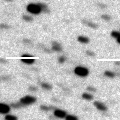
|
It is expected to approach to Sun down to 0.2 a.u. and brighten up to 3 mag in August. Now it is 16.4 mag (May 17, Toshihiko Ikemura, Hirohisa Sato). In the Northern Hemisphere, it stays observable in the morning sky until early August when the comet brightens up to 6 mag. It is not observable at all in the Southern Hemisphere.
Date(TT) R.A. (2000) Decl. Delta r Elong. m1 Best Time(A, h)
June 9 1 33.90 58 12.2 2.074 1.649 51 13.8 3:00 (219, 34)
June 16 1 57.80 58 48.4 1.919 1.523 52 13.2 2:58 (218, 34)
|
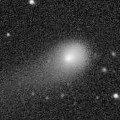
|
Now it is very bright as 12.0 mag (May 15, Juan Jose Gonzalez). It will be observable at 12-13 mag for a long time from 2017 to 2018. In the Southern Hemisphere, it will be hardly observable after this.
Date(TT) R.A. (2000) Decl. Delta r Elong. m1 Best Time(A, h)
June 9 12 15.83 52 27.1 3.867 3.855 81 13.4 20:58 (139, 63)
June 16 12 6.26 51 1.1 3.979 3.871 76 13.5 21:02 (132, 58)
|

|
Now it is 14.8 mag (May 10, Toshihiko Ikemura, Hirohisa Sato).
Date(TT) R.A. (2000) Decl. Delta r Elong. m1 Best Time(A, h)
June 9 23 17.26 0 12.8 5.733 5.781 87 13.5 3:00 (298, 34)
June 16 23 18.84 0 33.4 5.623 5.780 93 13.5 2:58 (303, 38)
|
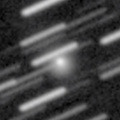
|
Now it is 14.8 mag (May 14, Toshihiko Ikemura, Hirohisa Sato). It will brighten up to 13 mag in 2019 spring. In the Northern Hemisphere, it stays observable in good condition for a long time. In the Southern Hemisphere, it locates extremely low until summer.
Date(TT) R.A. (2000) Decl. Delta r Elong. m1 Best Time(A, h)
June 9 18 22.32 46 23.0 3.423 3.870 108 14.5 1:15 (180, 79)
June 16 18 7.30 45 47.7 3.360 3.835 110 14.5 0:33 (180, 79)
|
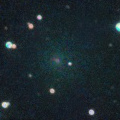
|
It brightened very rapidly. Now it is very bright as 11.8 mag (May 16, Juan Jose Gonzalez). It may fade out very rapidly in June. In the Northern Hemisphere, it stays observable until it fades out. It is not observable in the Southern Hemisphere.
Date(TT) R.A. (2000) Decl. Delta r Elong. m1 Best Time(A, h)
June 9 4 58.63 84 8.8 1.786 1.574 61 14.9 3:00 (185, 31)
June 16 4 36.79 84 22.3 1.808 1.591 61 17.1 2:58 (186, 32)
|

|
Now it is 15.2 mag (May 21, Martin Masek). It stays 15 mag from 2018 to 2019, and it will be observable for a long time in the Southern Hemisphere. In the Northern Hemisphere, it will never be observable again.
Date(TT) R.A. (2000) Decl. Delta r Elong. m1 Best Time(A, h)
June 9 12 2.15 -66 32.2 3.881 4.425 116 15.1 20:58 ( 12,-14)
June 16 11 59.40 -66 2.3 3.893 4.398 113 15.1 21:02 ( 16,-16)
|

|
It brightened up to 7.1 mag from May to June in 2017 (June 21, Juan Jose Gonzalez). Now it is fading. It has already faded down to 14.6 mag (May 14, Thomas Lehmann). In the Southern Hemisphere, it stays observable for a long time after this. It will never be observable again in the Northern Hemisphere.
Date(TT) R.A. (2000) Decl. Delta r Elong. m1 Best Time(A, h)
June 9 1 42.17 -43 45.9 4.551 4.515 81 15.2 3:00 (310,-19)
June 16 1 48.23 -44 12.8 4.549 4.579 85 15.2 2:58 (313,-16)
|
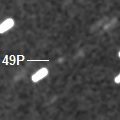
|
The condition is worst in this apparition. It brightens up to 14.5 mag from June to August, but it is not observable at all.
Date(TT) R.A. (2000) Decl. Delta r Elong. m1 Best Time(A, h)
June 9 4 45.69 13 14.5 2.470 1.486 10 15.4 3:00 (234,-22)
June 16 5 8.19 14 29.5 2.451 1.467 11 15.2 2:58 (234,-20)
|

|
Now it is 20.7 mag (May 25, J. V. Scotti). It will brighten rapidly, and it is expected to brighten up to 10 mag in autumn. But actually, it is much fainter than this ephemeris. It will be observable in excellent condition in the Northern Hemisphere. It stays low in the Southern Hemisphere.
Date(TT) R.A. (2000) Decl. Delta r Elong. m1 Best Time(A, h)
June 9 22 48.71 -4 44.2 1.811 2.169 96 15.8 3:00 (308, 35)
June 16 22 58.14 -3 9.8 1.687 2.115 100 15.5 2:58 (311, 39)
|

|
Now it is 17.2 mag (May 21, Martin Masek). It is observable at 15 mag in 2018, in good condition in the Southern Hemisphere. It locates somewhat low in the Northern Hemisphere.
Date(TT) R.A. (2000) Decl. Delta r Elong. m1 Best Time(A, h)
June 9 23 17.64 -15 16.5 2.899 3.131 93 15.6 3:00 (310, 23)
June 16 23 22.25 -15 10.6 2.818 3.143 99 15.5 2:58 (314, 26)
|
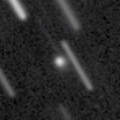
|
It brightened rapidly. Now it is 15.8 mag (May 14, Toshihiko Ikemura, Hirohisa Sato). It stays 15.5 mag until June.
Date(TT) R.A. (2000) Decl. Delta r Elong. m1 Best Time(A, h)
June 9 14 43.45 23 55.1 1.225 1.958 121 15.7 21:32 ( 0, 79)
June 16 14 43.64 19 53.1 1.251 1.964 119 15.8 21:05 ( 0, 75)
|
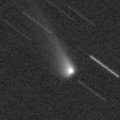
|
Now it is 17.2 mag (May 19, CAO, San Pedro de Atacama). Fading now. It stays observable in good condition for a long time after this in the Southern Hemisphere. It is not observable until June in the Northern Hemisphere.
Date(TT) R.A. (2000) Decl. Delta r Elong. m1 Best Time(A, h)
June 9 0 59.87 -10 42.3 4.761 4.502 69 15.9 3:00 (288, 7)
June 16 1 0.45 -11 44.8 4.658 4.521 75 15.9 2:58 (293, 12)
|

|
It will brighten up to 14 mag in winter. It will be observable in excellent condition in the Northern Hemisphere. In the Southern Hemisphere, it is observable only until August.
Date(TT) R.A. (2000) Decl. Delta r Elong. m1 Best Time(A, h)
June 9 2 20.42 13 56.1 3.054 2.374 40 16.0 3:00 (257, 5)
June 16 2 31.10 16 3.8 2.959 2.338 44 15.9 2:58 (257, 10)
|
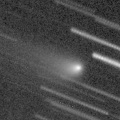
|
It is fading now, but it stays 16 mag until summer. But actually, it is 18.1 mag (Mar. 23, Toshihiko Ikemura, Hirohisa Sato), fainter than this ephemeris.
Date(TT) R.A. (2000) Decl. Delta r Elong. m1 Best Time(A, h)
June 9 17 11.77 -28 17.9 2.934 3.945 174 16.0 0:06 ( 0, 27)
June 16 16 55.35 -28 14.1 2.990 3.993 169 16.1 23:15 ( 0, 27)
|

|
Now it is 15.5 mag (Mar. 16, iTelescope Observatory, Siding Spring). It brightens up to 16 mag in spring. In the Southern Hemisphere, it stays observable until August, but it will be unobservable after that. In the Northern Hemisphere, it stays unobservable until June, but it will be observable in good condition after that. Its cometary activity was observed on Mar. 26 (M. Mommert, D. Polishook, N. Moskovitz).
Date(TT) R.A. (2000) Decl. Delta r Elong. m1 Best Time(A, h)
June 9 1 21.34 1 39.7 1.508 1.309 58 16.1 3:00 (275, 10)
June 16 1 34.87 5 37.0 1.504 1.340 60 16.1 2:58 (274, 15)
|

|
Now it is 16.7 mag (May 13, Hidetaka Sato). It will brighten rapidly after this, and it is expected to brighten up to 9 mag from autumn to winter. In the Northern Hemisphere, it stays observable in good condition for a long time until it fades out. In the Southern Hemispehre, it is observable in good condition until autumn, but it will be low in winter.
Date(TT) R.A. (2000) Decl. Delta r Elong. m1 Best Time(A, h)
June 9 1 48.11 -5 5.6 2.860 2.444 56 16.5 3:00 (277, 1)
June 16 2 0.97 -4 0.1 2.742 2.386 59 16.1 2:58 (278, 4)
|
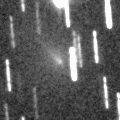
|
It stays observable at 16.5 mag for a while. It will be observable in good condition after this in the Southern Hemisphere. But it stays low in the Northern Hemisphere.
Date(TT) R.A. (2000) Decl. Delta r Elong. m1 Best Time(A, h)
June 9 22 0.71 -22 36.8 1.444 2.066 113 16.4 3:00 (330, 27)
June 16 21 37.12 -27 32.4 1.364 2.127 126 16.5 2:58 (344, 26)
|
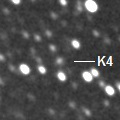
|
Now it is 17.2 mag (May 21, Toshihiko Ikemura, Hirohisa Sato). It was observed at 16 mag from summer to autumn in 2017. It will be observable at 16.5 mag in good condition also in 2018. It locates somewhat low in the Southern Hemisphere.
Date(TT) R.A. (2000) Decl. Delta r Elong. m1 Best Time(A, h)
June 9 0 32.17 17 31.1 3.348 3.047 64 16.5 3:00 (268, 29)
June 16 0 39.39 18 53.4 3.302 3.081 68 16.5 2:58 (270, 34)
|
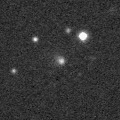
|
Unexpectedly, it brightened rapidly. Now it is 16.6 mag (May 15, Toshihiko Ikemura, Hirohisa Sato). It stays at 16.5 mag until July.
Date(TT) R.A. (2000) Decl. Delta r Elong. m1 Best Time(A, h)
June 9 12 32.66 1 33.4 1.538 2.100 108 16.5 20:58 ( 39, 50)
June 16 12 39.26 1 11.6 1.596 2.088 103 16.5 21:02 ( 46, 46)
|

|
Now it is 15.9 mag (May 4, Kunihiro Shima). It will be fading slowly until summer.
Date(TT) R.A. (2000) Decl. Delta r Elong. m1 Best Time(A, h)
June 9 11 29.06 10 32.9 3.405 3.567 90 16.6 20:58 ( 66, 46)
June 16 11 32.98 9 52.9 3.507 3.571 85 16.7 21:02 ( 71, 40)
|

|
Now it is 16.6 mag (May 10, Toshihiko Ikemura, Hirohisa Sato). It will be fading slowly after this.
Date(TT) R.A. (2000) Decl. Delta r Elong. m1 Best Time(A, h)
June 9 10 23.60 9 18.9 9.864 9.675 76 16.9 20:58 ( 77, 33)
June 16 10 25.61 9 17.4 9.979 9.682 70 16.9 21:02 ( 82, 27)
|
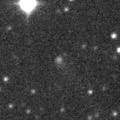
|
Now it is 16.9 mag (May 15, Toshihiko Ikemura, Hirohisa Sato). It will be fainter than 18 mag in summer.
Date(TT) R.A. (2000) Decl. Delta r Elong. m1 Best Time(A, h)
June 9 14 31.26 -6 6.2 5.673 6.472 138 16.9 21:20 ( 0, 49)
June 16 14 29.47 -5 26.7 5.773 6.492 131 16.9 21:02 ( 4, 49)
|
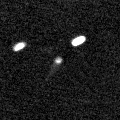
|
Now it is 16.7 mag (May 10, Toshihiko Ikemura, Hirohisa Sato). It will brighten up to 15 mag in January, 2019. It stays observable in excellent condition in the Northern Hemispehre. It is observable only until June in the Southern Hemisphere.
Date(TT) R.A. (2000) Decl. Delta r Elong. m1 Best Time(A, h)
June 9 10 28.58 34 56.5 4.092 3.856 69 16.9 20:58 (106, 45)
June 16 10 26.70 34 59.1 4.173 3.823 63 16.9 21:02 (109, 39)
|

|
Now it is 16.8 mag (May 15, Toshihiko Ikemura, Hirohisa Sato). It will be fading gradually after this, and it will be fainter than 18 mag in winter. In the Northern Hemisphere, it stays observable in good condition for a long time. In the Southern Hemisphere, it will never be observable again.
Date(TT) R.A. (2000) Decl. Delta r Elong. m1 Best Time(A, h)
June 9 23 30.92 72 8.0 7.604 7.259 66 17.0 3:00 (199, 45)
June 16 23 36.57 72 52.2 7.606 7.282 67 17.0 2:58 (197, 46)
|
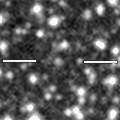
|
Now it is 18.0 mag (May 15, Toshihiko Ikemura, Hirohisa Sato). It stays observable at 17 mag in good condition from spring to autumn.
Date(TT) R.A. (2000) Decl. Delta r Elong. m1 Best Time(A, h)
June 9 21 2.24 1 22.8 5.446 5.990 117 17.1 3:00 (336, 54)
June 16 21 2.12 1 39.5 5.361 5.990 124 17.1 2:58 (347, 56)
|

|
Now it is bright as 18.0 mag (May 14, Hidetaka Sato). Hidetaka Sato pointed out its cometary activity. In the Northern Hemisphere, it stays observable at 18 mag until June. It is not observable in the Southern Hemisphere.
Date(TT) R.A. (2000) Decl. Delta r Elong. m1 Best Time(A, h)
June 9 8 0.49 45 25.9 2.042 1.450 41 17.9 20:58 (130, 23)
June 16 8 17.64 47 46.5 2.074 1.454 40 18.0 21:02 (134, 22)
|
|
![]()
 65P/Gunn
65P/Gunn C/2018 C2 ( Lemmon )
C/2018 C2 ( Lemmon ) C/2015 V1 ( PanSTARRS )
C/2015 V1 ( PanSTARRS ) (944) Hidalgo
(944) Hidalgo C/2015 VL62 ( Lemmon-Yeung-PanSTARRS )
C/2015 VL62 ( Lemmon-Yeung-PanSTARRS ) (3552) Don Quixote
(3552) Don Quixote 38P/Stephan-Oterma
38P/Stephan-Oterma C/2017 S6 ( Catalina )
C/2017 S6 ( Catalina ) C/2017 K4 ( ATLAS )
C/2017 K4 ( ATLAS ) 105P/Singer Brewster
105P/Singer Brewster 74P/Smirnova-Chernykh
74P/Smirnova-Chernykh C/2014 B1 ( Schwartz )
C/2014 B1 ( Schwartz ) C/2017 E3 ( PanSTARRS )
C/2017 E3 ( PanSTARRS ) C/2018 A3 ( ATLAS )
C/2018 A3 ( ATLAS ) C/2014 OE4 ( PanSTARRS )
C/2014 OE4 ( PanSTARRS ) C/2017 M5 ( TOTAS )
C/2017 M5 ( TOTAS ) 2018 EN4
2018 EN4![]()





























